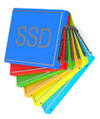
Photo by Mirko Blicke on Unsplash
Software RAID in Windows, macOS, and Linux
Solid Foundation
Windows, Linux, and macOS offer a wide range of alternatives for creating software RAID data storage. However, RAID as a software solution does not make sense in some cases because the performance is less than optimal and parity information is not calculated by a dedicated processor. Additionally, it does not support hot swap – that is, the ability to replace hard drives on the fly. Hardware solutions are generally recommended for RAID (redundant array of independent disks) systems, but sometimes admins might find software RAID on their servers useful.
Software RAID in Windows
In addition to storage pools, legacy disks, spanned volumes, and striped volumes, Windows Server allows you to create a software-based RAID5 system, as well as a mirrored volume that requires two hard drives to which all information is written and from which you can boot. If you are creating a disk that spans more than one physical drive, you need to select the disks that you want to include when defining the drive type. For the configuration, use the Disk Management tool, which you launch by calling diskmgmt.msc. For software RAID in Windows Server 2019, you can also use the resilient filesystem (ReFS). Creating and managing software RAID will be similar to using NTFS, with the benefit of the higher stability of ReFS.
Setting Up Disks
After initializing, you can view and set up the volumes in Disk Manager. If you are configuring a specific storage system, such as software RAID or a storage pool, and you need to convert a hard drive, you are automatically prompted. Once the disks are established, you can set them up with logical drives. The drives, simply referred to as "Disk 0," "Disk 1," and so on, in Windows Server, can be created with the New Simple Volume option in the context menu of the free space you
...Buy this article as PDF
(incl. VAT)
Buy ADMIN Magazine
Subscribe to our ADMIN Newsletters
Subscribe to our Linux Newsletters
Find Linux and Open Source Jobs
Most Popular
Support Our Work
ADMIN content is made possible with support from readers like you. Please consider contributing when you've found an article to be beneficial.







